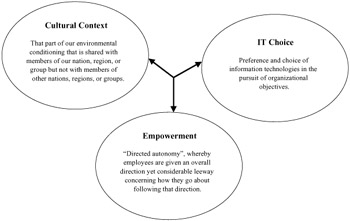Introduction
|
| < Day Day Up > |
|
Geographically, the borders that have separated countries for years still exist. However, from the perspective of industrial and financial activity, these borders are rapidly disappearing. The emergence of global supply chains, electronic commerce, and common currencies have heightened both expectations and anxieties among top corporations seeking to enter, sustain, or expand firm presence in international markets. The potential rewards of successful global competition include market expansion, economies of scale, and consequently, competitive advantage (Porter, 1990). However, to reap these benefits, corporate planners must develop organizational structures and supporting technology that facilitate both internal and external coordination. While advanced communications and computing technologies (IT) have, in some instances, moderated the numerous complexities of global competition, many organizations have yet to master the interaction and complexities that geographical, language, organizational, regulatory, and cultural differences have imposed on their transnational IS functions (Tillquist, 1997). As noted by Karimi and Konsynski (1991), "...while many global firms have an explicit business strategy, few have a corresponding strategy for managing information technology internationally...."
Keen (1987) notes two sets of barriers that inhibit development of effective global IT strategies. The first set, regulatory and standards differences across countries, is in many cases beyond the control of business entities. These external issues pertain to: (1) government regulation of telecommunications channels, and (2) communication protocols that have evolved over time and frequently vary between nationalities. The second set of internal barriers concerns management knowledge and appreciation for the subtle differences in culture, economics, education, and business practice that influence the way professionals think about and interact with information technology across national boundaries. As noted by Keen, too many telecommunications and information systems managers see the world through domestic-tinted glasses. Often they overlook important differences in IT organization and practice between US, European, and Asian firms. Thus, domestic assumptions regarding IT management are projected onto a very different international context. In many instances both organizational and IT structures that have evolved in other countries are "written off" as irrelevant when in fact these structures may be optimal within the regulatory and cultural environment in which they were created.
In sum, the complexities of international competition and its dependence on IT have created numerous managerial concerns of both technical and sociological dimensions. In addition, it has necessitated an important area of theory building and empirical research that, until recently, has been under-represented in IS. While much has been written about largely uncontrollable regulatory and technical issues associated with international computing (King & Sethi, 1992; Sethi & Olson, 1991), little is known about the sociological complexities or patterns in IT management across nationalities (with the notable exception of Guimaraes et al., 1999). Of particular interest is how members of various cultures use IT to achieve goals important in successful organizational life. Among the most important of these goals is empowerment. Clearly, much can be learned about using IT to achieve empowerment by casting the relationship in the research context of cross-cultural comparison.
In this spirit, the primary goal of this research is to examine differences across cultures in the use of IT. Specifically, this study examines the relationship between national culture and choice of IT in the pursuit of employee empowerment. Understanding how various cultural contexts may influence choice of IT and empowerment is an important step in more fully developing effective global IT deployment policies. In addition, such a study opens a potentially interesting avenue of theory building for researchers interested in cultural perceptions of IT and its usefulness in building empowerment. The overall model for the study is illustrated in Figure 1. The following sections define its key concepts.

Figure 1: Cultural Context, IT Choice and Empowerment.
|
| < Day Day Up > |
|
EAN: 2147483647
Pages: 207